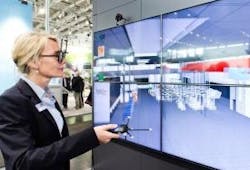It's fair to say that a good part of the changes involve sensor technology being applied in the industrial setting. As we move to a sensor-driven industrial environment, we will begin to see a range of applications built to take advantage of that data and automate many manual tasks or create efficiencies that simply weren't possible without this kind of information.
But VW, which is presenting at the Fair, doesn't think this means the end of the worker as we squeeze greater efficiencies from the manufacturing process. Quite the contrary, industry will continue to need skilled labor, but labor with a different set of skills. Olaf Katzer, Head of Job Training and Education at VW, was quoted in an article on the Fair website.
Another area that's changing is that people are wearing smart glasses with increasing frequency and it's likely this could be the norm in industry in the coming years. As I wrote on TechCrunch recently, Google Glass Is Alive And Well And Living In The Enterprise. The point was that while it didn't do great as a consumer device, Glass (and other smart glasses) is finding new life in the Enterprise with lots of companies looking for ways to use smart glasses technology in an industrial setting.
An article on the Fair website, also looked at "augmented reality in the factory," certainly an interesting way of looking at it, and they are thinking of it more from a customer perspective such as downloading an IKEA app that would enable you to see how the couch you like fits in your living room, which is a pretty cool idea.
But how about applying that same concept to design, so that an engineer can see a 3D representation of his or her design and see how well a particular part fits or doesn't fit in the design. While this type of technology has been around for some time, it's getting less complex to implement, which could help mainstream it as we move forward.
All of these technologies are designed to enhance the factory of the future and change the way we interact with and understand what's happening on the factory floor during the manufacturing process -- or how customers are interacting with the shopping experience.
As we undertake each of these future-facing approaches, the common denominator will be lots of data and the need to understand that data, whether it's coming from sensors, from smart glasses or smart shopping and design applications. It's all going to transmit information, and the key to getting ahead in the industry of the future won't be just applying these technologies, but making the best use of the data they are generating.
The Hannover Technology Fair will continue to explore these ideas and more this week as we move ever closer to the industry of the future.
Ron Miller is a freelance technology journalist, blogger, enterprise reporter at TechCrunch and Contributing Editor at EContent Magazine. He has been writing about technology since 1988 when he began working as a technical writer. Past gigs include FierceContentManagement, CITEworld, Computerworld, TechTarget and many others. He co-founded socmedianews.com (originally socmedia101.com) in 2009 and contributes regularly to its content. You can learn more by visiting his blog, by Ron Miller at http://byronmiller.typepad.com.





